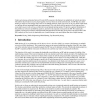Free Online Productivity Tools
i2Speak
i2Symbol
i2OCR
iTex2Img
iWeb2Print
iWeb2Shot
i2Type
iPdf2Split
iPdf2Merge
i2Bopomofo
i2Arabic
i2Style
i2Image
i2PDF
iLatex2Rtf
Sci2ools
ANOR
2006
2006
Top percentile network pricing and the economics of multi-homing
Under multi-homing an Internet Service Provider (ISP) connects to the Internet via multiplicity of network providers. This allows the provider to receive proper quality of service when one of the networks fails. An ISP that uses multihoming is subject to extra charges due to the use of multiple networks. Such extra costs can be very drastic under fixed cost pricing and non-meaningful under per-usage pricing. This work deals with the question of how large are these costs under top-percentile pricing, a relatively new and popular pricing regime. We provide a general formulation of this problem as well as its probabilistic analysis, and derive the expected cost faced by the ISP. We numerically examine several typical scenarios and demonstrate that despite the fact that this pricing aims at the peak traffic of the ISP (similarly to fixed cost), the bandwidth cost of multi-homing is not much higher than that of single-homing.
| Added | 10 Dec 2010 |
| Updated | 10 Dec 2010 |
| Type | Journal |
| Year | 2006 |
| Where | ANOR |
| Authors | Joseph Levy, Hanoch Levy, Yaron Kahana |
Comments (0)

